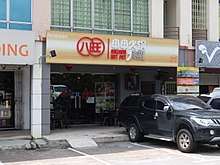Hot pot
|
A common hotpot preparation: raw foods ready to be cooked, with hot broth at the center of the table. | |
| Course | Main dishes |
|---|---|
| Place of origin | China |
| Main ingredients | Meat, leaf vegetables, mushrooms, dumplings, and seafood |
| Hot pot | |||||||||||||||||
.svg.png) "Hotpot" in Traditional (top) and Simplified (bottom) Chinese characters | |||||||||||||||||
| Traditional Chinese | 火鍋 | ||||||||||||||||
|---|---|---|---|---|---|---|---|---|---|---|---|---|---|---|---|---|---|
| Simplified Chinese | 火锅 | ||||||||||||||||
| Literal meaning | "fire pot" | ||||||||||||||||
| |||||||||||||||||
| Cantonese name | |||||||||||||||||
| Traditional Chinese | 打邊爐 or 打甂爐 | ||||||||||||||||
| Simplified Chinese | 打边炉 or 打甂炉 | ||||||||||||||||
| |||||||||||||||||
Hot pot is a Chinese cooking method, prepared with a simmering pot of soup stock at the dining table, containing a variety of East Asian foodstuffs and ingredients. While the hot pot is kept simmering, ingredients are placed into the pot and are cooked at the table. Typical hot pot dishes include thinly sliced meat, leaf vegetables, mushrooms, wontons, egg dumplings, tofu, and seafood. The cooked food is usually eaten with a dipping sauce.
Common ingredients
.jpg)
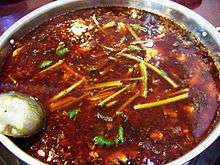
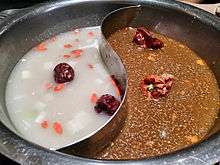
- Basic stock is often made using:
- Meats and protein vary, and can include:
- Thinly sliced lamb, goat, beef, sometimes pork, chicken or other poultry
- Fish
- Prawns
- Scallops
- Cockles
- Clams
- Mussels
- Beef balls
- Fish balls
- Shrimp balls
- Fish slices
- Offal, especially beef tripes
- Blood tofu
- Squid
- Crab
- Lobster
- Crawfish
- Octopus
- Geoduck
- Cuttlefish
- Sea cucumber
- Tofu, Tofu skin, Fu zhu, frozen tofu or fried tofu
- Egg dumplings (dàn jiǎo)
- Kamaboko and crab stick
- Mantis shrimp
- Starches include:
- Vegetables include (but are not limited to):
- Bok choy
- Napa cabbage
- Crown daisy
- Spinach
- Lettuce
- Carrots
- Winter melon
- Bean sprouts
- Daikon
- Potatoes and Sweet Potatoes
- Varieties of mushrooms, straw mushroom, enoki mushrooms (jinzhengu), Shiitake (xianggu), oyster mushrooms, etc
- Taro
- Pumpkin
- Watercress
- Haidai (Seaweed)
- Cilantro
- Condiments:
- Sesame butter
- Hoisin sauce
- Soy sauce
- Vinegar (white or black)
- Cilantro
- Minced Garlic
- Scallion
- Sesame oil
- Shacha sauce
- Chili oil
- Chive flower paste (韭菜花酱)
- Pickled tofu (腐乳)
- White pepper
- XO sauce
- Douchi
Regional variations
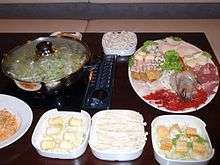
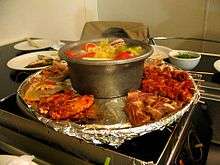
Mainland China
Different kinds of hot pots can be found in Chongqing and Sichuan – typically, more modern eateries offer the sectioned bowl with differently flavored broths in each section. More traditional or older establishments serve a fragrant, mild broth in the hot pot, which is a large brass vessel heated by burning coals in a central chimney. The broth is boiled in a deep, donut-shaped bowl surrounding the chimney.
One of the most famous variations is the Chongqing hot pot (Chongching) má là (Chinese: 麻辣 – "numb and spicy") hot pot, to which Sichuan pepper (Chinese: 花椒 huā jiāo "flower pepper"; also known as "prickly ash") is added. It is usual to use a variety of different meats as well as sliced mutton fillet. A Chongqing hotpot is markedly different from the types eaten in other parts of China. Quite often the differences lie in the meats used, the type of soup base, and the sauces and condiments used to flavor the meat.
Má là huǒ guō could be used to distinguish from simply huǒ guō in cases when people refer to the "Northern Style Hot Pot" in China. Instant-boiled mutton (Chinese: 涮羊肉; pinyin: Shuàn Yángròu) could be viewed as representative of this kind of food, which does not focus on the soup base.
Sichuan also has a number of dry hot pots such as "Malaxiangguo" which are similar to those described above, but lack the soup base. Otherwise, similar ingredients are used and the dish served in a similar manner.
In neighbouring Yunnan, although spicy broths are equally popular, there is another predominant type of hot pot that is made with various wild or planted mushrooms. The big difference between the mushroom hot pot and the spicy hot pot is that the former rarely uses spice and chili in order to keep the original flavor of the mushrooms. The mushroom hot pot is also seasonal, depending on the availability of local mushrooms.
The Manchurian hot pot (Chinese: 東北酸菜火鍋) uses plenty of suan cai (Chinese sauerkraut) (Chinese: 酸菜; pinyin: suān cài) to make the pot's stew sour.
A Cantonese variation includes mixing a raw egg with the condiments to reduce the amount of "heat" absorbed by the food, thereby reducing the likelihood of a sore throat after the steamboat meal, according to Chinese herbalist theories.
In Hubei, hot pot is normally prepared with hot spice and Sichuan pepper. Items supplied to be cooked in this broth include mushrooms, thinly shaved beef or lamb, lettuce, and various other green vegetables.
In Hainan cuisine hot pot is generally served in small woks with a prepared broth containing pieces of meat. At the time of serving, the meat is not fully cooked. Approximately fifteen minutes is required before it is ready to eat. Items supplied to be cooked in this type of hot pot include mushrooms, thinly shaved beef or goat meat (referred to as mutton), lettuce, and other green vegetables. This dish varies somewhat in different parts of the province.
Japan
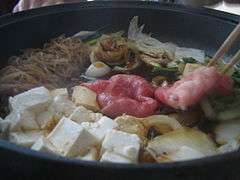
In Japan, hot pot dishes are called nabemono. There are dozens of varieties of hot pots, and each hot pot has a distinguished flavor and style.
Sukiyaki is one of the most popular hot pot dishes among the Japanese, and undoubtedly the most well-known Japanese hot pot overseas, particularly in English-speaking parts of the world. Sukiyaki hot pot is served with sliced beef, vegetables and tofu in a sweet sauce based on soy sauce, which is only used in small amounts, enough for the ingredients to merge in a shallow iron pot. Before being eaten, the ingredients are usually dipped in a small bowl of raw, beaten eggs.
Shabu-shabu is another popular hot pot in Japan. Shabu-shabu hot pot is prepared by submerging a very thin slice of meat or a piece of vegetable in a pot of broth made with kelp (kombu) and swishing it back and forth several times. The familiar swishing sound is where the dish gets its name. Shabu-shabu directly translates to "swish swish." Cooked meat and vegetables are usually dipped in ponzu or goma (sesame seed) sauce before eating. Once the meat and vegetables have been eaten, leftover broth from the pot is customarily combined with the remaining rice, and the resulting soup is usually eaten last.
Because the shabu-shabu hot pot cooks beef "blue rare" to rare, use of high-grade Japanese beef is preferred. Typically, shabu-shabu is considered a fine dining dish, due to the quality of the meat used, and the price charged for it at restaurants in Japan.
Both sukiyaki and shabu-shabu, rice or noodle is cooked with remained broth along with additional ingredients at the very end of the meal. This menu is called shime, ending the meal. Traditionally, hot pots are considered fall and winter dishes.
Other regions
In Cambodia, hot pot is called Yao Hon (យ៉ាវហន) or other regions call it Chhnang Pleurng (ឆ្នាំងភ្លើង), which literally translates to Pot Fire. It is usually eaten during celebrations or family gatherings. Just like the Chinese Hot Pot, Cambodian hot pot consist of all the same ingredients although the dish differs in that coconut milk is used as the base of the soup. Another variation of the dish is called "Buttered Yao Hon" or "Buttered Chhnang Pleurng" where all the same ingredients are used but except cooking in coconut milk soup it is cooked on a flat grill pan where butter is used as the base. It is similar to the Korean Barbecue. An herb sauce usually assist with the "Buttered Yao Hon" since all the ingredients are not flavored. [1]
Taiwanese hot pot (usually called 火鍋 in Mandarin or Taiwanese) is also called shabu-shabu when the food is prepared in Japanese style. It is very common to eat the food with a dipping sauce consisting of shacha sauce and raw egg yolk.
In Thailand, hotpot is called Thai suki, although it is quite different from the Japanese shabu-shabu variation called sukiyaki. Originally a Chinese-style hot pot, the number of ingredients to choose from was greatly increased and a Thai-style dipping sauce with chili sauce, chilli, lime, and coriander leaves was added. Another variation is Mu kratha, the Thai hot pot, which originated from Korean barbecue combined with Thai suki.[2]
In Vietnam, a hot pot is called lẩu or cù lao, and the sour soup called canh chua is often cooked in hot pot style (called lẩu canh chua). The generic term for a salted fish hot pot is lẩu mắm.
In the Philippines, the term Hot Pot has a different meaning and context when it comes to Chinese-Influenced Filipino Cuisines. Usually served by Chinese Restaurants (particularly Harbour City Dimsum among others), the Hot Pot is literally a huge pot (with cover) filled with cooked rice, choices of beef, pork or chicken slices, special sauce and choice vegetables such as broccoli, carrots, shallots, gingers, pechay, kangkong leaves and spices and some slices of hard-boiled eggs on top and is usually served piping hot and is to be accompanied by other Filipino Dimsum Favorites and drinks.[3][4]
Related dishes
- Instant-boiled mutton
- Jjigae Chongol - Korea
- Nabemono - Japan
- Yao Hon (យ៉ាវហន) or Chhnang Pleurng (ឆ្នាំងភ្លើង) - Cambodia
- Buttered Chhnang Pleurng
- Thai suki
- Mu kratha – also called "Thai hot pot" or mookata
- Clay pot cooking – referred to as "hot pot" or "hotpot" on Chinese restaurant menus in English-speaking regions
- Lancashire hotpot – a dish referred to as "hot pot" (or "hotpot") in Britain
- Stew
- Yong tau foo
- Fondue Bourguignonne & Fondue chinoise
See also
References
- ↑ Srey, Kim. "Mami-Eggroll: "Yow Hon" for Two". mami-eggroll.com.
- ↑ MooJaa, Mookata Thai BBQ Steamboat, 19. October 2015.
- ↑ "Restaurants and Restaurant Reservations - OpenTable". www.foodspotting.com.
- ↑ "harbor city dimsum - Foodie Travels Cebu". foodietravelscebu.wordpress.com.
External links



